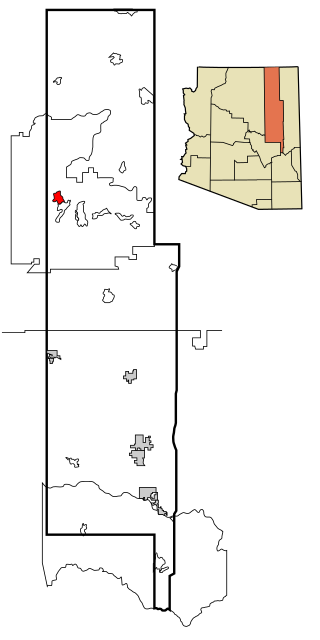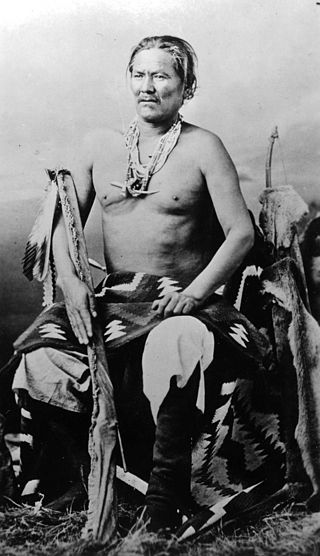
The Hopi are Native Americans who primarily live in northeastern Arizona. The majority are enrolled in the Hopi Tribe of Arizona and live on the Hopi Reservation in northeastern Arizona; however, some Hopi people are enrolled in the Colorado River Indian Tribes of the Colorado River Indian Reservation at the border of Arizona and California.

The Hopi maintain a complex religious and mythological tradition stretching back over centuries. However, it is difficult to definitively state what all Hopis as a group believe. Like the oral traditions of many other societies, Hopi mythology is not always told consistently and each Hopi mesa, or even each village, may have its own version of a particular story, but "in essence the variants of the Hopi myth bear marked similarity to one another." It is also not clear that the stories told to non-Hopis, such as anthropologists and ethnographers, represent genuine Hopi beliefs or are merely stories told to the curious while keeping safe the more sacred Hopi teachings. As folklorist Harold Courlander states, "there is a Hopi reticence about discussing matters that could be considered ritual secrets or religion-oriented traditions."

Hotevilla-Bacavi is a census-designated place (CDP) in Navajo County, Arizona, United States, on the Hopi Reservation. The population was 957 at the 2010 census.

Kykotsmovi Village, also known as K-Town or New Oraibi is a census-designated place (CDP) in Navajo County, Arizona, United States. It is the seat of tribal government of the Hopi Reservation, a sovereign nation located in northeastern Arizona. The Hopi word is spelled Kiqötsmovi and means "mound of ruined houses". The population was 776 at the 2000 census. The Hopi reservation occupies part of Coconino and Navajo counties, encompasses more than 1.5 million acres, and is made up of 12 villages on three mesas. Kykotsmovi is one of the 12 villages located in third mesa. Third Mesa includes Hotvela (Hotevilla), Paaqavi (Bacavi), Munqapi (Moencopi), Kiqotsmovi (Kykotsmovi), and Orayvi (Oraibi).

Nampeyo was a Hopi-Tewa potter who lived on the Hopi Reservation in Arizona. Her Tewa name was also spelled Num-pa-yu, meaning "snake that does not bite". Her name is also cited as "Nung-beh-yong," Tewa for Sand Snake.

Oraibi, also referred to as Old Oraibi, is a Hopi village in Navajo County, Arizona, United States, in the northeastern part of the state. Known as Orayvi by the native inhabitants, it is on Third Mesa on the Hopi Reservation near Kykotsmovi Village. There are no accurate census counts or estimates for the village population.

The Navajo are a Native American people of the Southwestern United States.
Spider Grandmother is an important figure in the mythology, oral traditions and folklore of many Native American cultures, especially in the Southwestern United States.

Tuba was a Hopi leader in the late 19th century. Tuba was the headman of the small Hopi village of Moencopi, roughly fifty miles west of the main villages on the Hopi mesas. However, he apparently was an important person in the village of Oraibi as well. Eventually, Tuba joined the Church of Jesus Christ of Latter-day Saints and later received his endowment in the St. George Temple. Tuba City, Arizona, was named in his honor.
Emory Sekaquaptewa was a Hopi leader and scholar from the Third Mesa village of Hotevilla. Known as the "First Hopi" or "First Indian," he is best known for his role in compiling the first dictionary of the Hopi language. He became assistant professor, Department of Anthropology, University of Arizona in 1972, and was Professor in its Bureau of Applied Research in Anthropology from 1990 to 2007. Emory received the 4th Annual Spirit of the Heard Award by the Heard Museum in October 2007.

Charles Sequevya Loloma was a Hopi Native American artist known for his jewelry. He also worked in pottery, painting and ceramics.
Thomas Banyacya, Sr. was a Hopi Native American traditional leader.
David Monongye was a Hopi Native American traditional leader. Nephew of Yukiuma, keeper of the Fire Clan tablets, who founded Hotevilla in 1906. He is one of four Hopis who decided or were appointed to reveal Hopi traditional wisdom and teachings, including the Hopi prophecies for the future, to the general public in 1946, after the use of the first two nuclear weapons on Japan.
Dan Evehema was a Hopi Native American traditional leader. He is one of four Hopis who decided or were appointed to reveal Hopi traditional wisdom and teachings, including the Hopi prophecies for the future, to the general public in 1946, after the use of the first two nuclear weapons against Japan. Evehema died on January 6, 1999, at approximately 106 years of age. In his "final message" he stated that he was the last of the group of four fully knowledgeable Hopis still alive. Evehema was co-author, with Thomas Mails, of "Hotevilla: Hopi Shrine of the Covenant : Microcosm of the World" and "Hopi Survival Kit" and co-author of Techqua Ikachi, the traditional Hopi newsletters produced from 1975 to 1986. The "Hopi Survival Kit" includes a signed affidavit from Dan Evehema approving the book, and is the only written account of the complete Hopi prophecies. Evehema was a member of the Greasewood/Roadrunner Clan.
Techqua Ikachi, Land – My Life is a feature documentary by Swiss/German director Anka Schmid, the Swiss artist Agnes Barmettler and the Hopi Native American James Danaqyumptewa from 1989. The documentary shows the history and life of Native Americans of the Hopi tribe in Arizona, in particular their problems with the American government in their fight for sovereignty. It is being told from the perspective of the Hopi tribe.
Anka Schmid is a film director, screenwriter and video artist. She is considered a German as well as a Swiss artist.

Iva Casuse Honwynum is a Hopi/Navajo artist, social activist, and cultural practitioner. A Native American, Honwynum is best known for her woven baskets and figurative sculpture. Honwynum's most important breakthrough was the development of the pootsaya basket, called "a rare innovation in Hopi basketry". She developed the pootsaya during her 2014 residency at the School for Advanced Research in Santa Fe, New Mexico, having been awarded the Eric and Barbara Dookin Artist Fellowship.

Polingaysi Qöyawayma, also known as Elizabeth Q. White, was a Hopi educator, writer, and potter.
Helen Sekaquaptewa (1898-1990), was a Hopi Mormon homemaker, matriarch and storyteller, best known for her as-told-to memoir, Me and Mine: The Life Story of Helen Sekaquaptewa, which was compiled by her friend Louise Udall based on Sekaquaptewa's recollections.
Tha 'Yoties, occasionally called Ed Kabotie and Tha 'Yoties, are a reggae rock band based in Flagstaff, Arizona.










